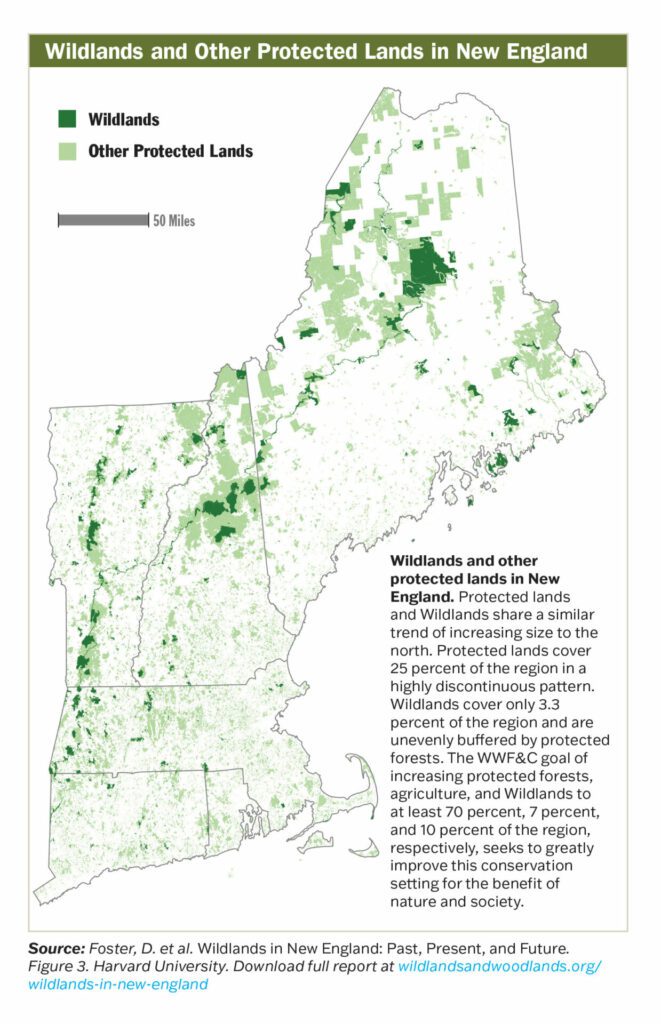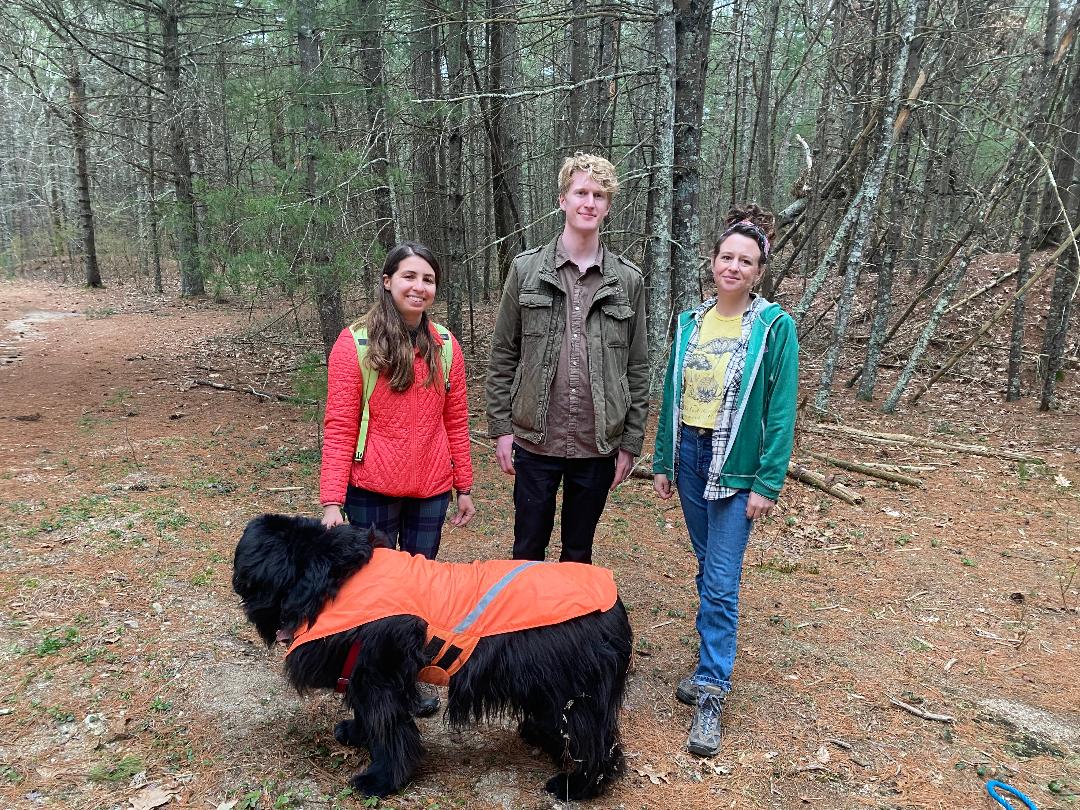Study: New England Needs to Conserve More Wildlands
Rhode Island has the least amount of wildlands, which enhance resilience from climate change, habitat fragmentation and biodiversity loss
June 26, 2023
PETERSHAM, Mass. — New England isn’t conserving enough wildlands to mitigate climate change or meet conservation goals.
That’s according to a new study released late last month by Wildlands, Woodlands, Farmlands and Communities (WWF&C), a coalition group of conservation organizations, educational institutions, local governments and private nonprofits.
The first-of-its-kind analysis, performed jointly by Harvard Forest of Harvard University, the Northeast Wilderness Trust and Highstead Foundation, examined how much wildlands — tracts of land where the management policy is to leave nature “alone” and allow natural processes to prevail without human interference — are preserved across the region, and the answer is: not much.
“The wild condition of the land derives not from the land’s history, but from its freedom to operate untrammeled, today and in the future,” wrote the study’s authors.
The study lays out three criteria for land to meet its wildlands definition: the land must have a deliberate wildland purpose; it must be allowed to mature freely under prevailing environmental conditions with minimal human intervention; and it must be protected in perpetuity.
The key factor in wildlands is time. In New England, where much of the land has been developed and used, wildlands are more likely to develop via natural rewilding, an ecological restoration practice that aims at reducing the influence of humans on ecosystems. Wildlands are more likely to look like recently clear-cut areas or former pastures than old growth forest.
Only 1.3 million acres, around 3.3% of New England’s total land area, protects wildlands across 426 individual properties, with much of it limited to the remote and rural areas of the region, a band of land that stretches from northwestern Connecticut to Baxter State Park in Maine. Meanwhile WWF&C has set a goal of preserving 10% of the region as wildlands.

The study found that half (54%) of all protected wildlands were located in Maine, despite 81% of the New England region counting as forestland.
As expected, Rhode Island has the least amount of wildland, according to the study. Only a single site meets the study’s criteria for wildlands: Oakland Forest, a 20-acre old growth forest owned by the Aquidneck Land Trust in Portsmouth.
Rhode Island has seen an increase in protected land over the past decade. Since 2010, the state has protected more than 9,000 acres of land, a 10% increase in total land protected by state programs.
In total, the state has protected over 166,000 acres of land, around 25% of the total land area. Approximately 135,000 acres of Rhode Island forests has been protected, around a third of the total forestland in the state, according to the study. Much of the protected land is actively managed by the state, private property owners or nonprofits, such as The Nature Conservancy.
Wildlands conservation has surged over the last two decades. According to the study, since 200 more than 660,000 acres of wildlands have been protected, with the number of agencies and organizations dedicated to their preservation now exceeding 100 entities.
“No properties, nor aggregations of properties, encompass landscapes large enough to support the full range of natural processes and human experience recommended by ecological science,” wrote the study’s authors. “Key species remain absent, including the region’s largest native predators — the wolf and cougar.”
A direct point of comparison for the study is New York State, where, despite having twice the population density as New England, an array of wildlands is preserved, including 16% of forest land and around 9% of the state’s total area as a whole. Adirondack Park, a network of public and private landowners in upstate New York, preserves 6 million acres in total, nearly 3 million of which are constitutionally protected as “forever wild.”
Conserving wildlands comes with key benefits for the environment. They are essential for maintaining and increasing biodiversity over time, and will support unique ecosystems and species that are missing from actively managed lands. Wildlands enhance resilience from climate change, habitat fragmentation and biodiversity loss.
Wildlands are also a key component for meeting the United Nations’ environmental goals: “30×30,” the colloquial title of the third of 23 targets adopted by the United Nations Convention on Biological Diversity, calls for 30% of the world’s land, water, coastal and marine areas to be in effective protection and management by 2030.
(In 2020 California enshrined 30×30 as a state conservation goal via executive order).
In its study, WWF&C lays out policy recommendations for New England states to meet its self-appointed goal of 10% of the region’s lands for wildlands preservation. The organization calls for a more robust network of preservation, increasing permanent protections to current wildlands, and increased public and private funding for conservation.
An interactive map of all the cataloged wildlands is available online as part of the study.




Rhode Island can have more Wildlands right now if DEM decides to follow the Natural Areas Protection Act of 1993 RIGL 42-122. By designating Natural Area Preserves in accordance with this law which would be environmentally sensitive areas protected in their natural state, meaning no logging or human disturbance, DEM could create Wildland areas on public and private land.
It is just a matter of the DEM Director designating an area to be a Natural Area Preserve, then a public hearing would be scheduled, and finally a Natural Area Preserve (Wildland) will be officially created.
Also, we could have had all Old Growth Forests protected as Wildlands this year through the Old Growth Forest Protection Act H5344, however, DEM opposed that legislation.
Why is DEM so reluctant to create Wildlands in Rhode Island? Are they so subservient to the timber industry that they cannot allow even a small percentage of public land be protected in their natural state from logging?
While 135,000 acres of forests in Rhode Island are “protected,” they are only protected from land development. None of these 135,000 acres are protected from logging including clearcutting.
Also, none of the Natural Heritage Areas are protected from logging which are areas that were identified by the now defunct Rhode Island Natural Heritage Program as being ecosystems containing rare, threatened, and endangered species.
Habitat for the endangered native Cerulean Warbler could be destroyed on public land at any time by tree service companies and loggers who are contracted to log on public land by DEM who often do a hack job since they are not the top Arborists in the state. On the contrary, they tend to have a history of environmental violations which DEM seems to not care about since they keep hiring those same companies.
DEM tends to prefer well connected tree service (logging) companies to give contracts out to instead of qualified ISA Certified Arborists.
DEM had 30 years to create Wildland areas, and the fact that they have not created one is beyond disgraceful.